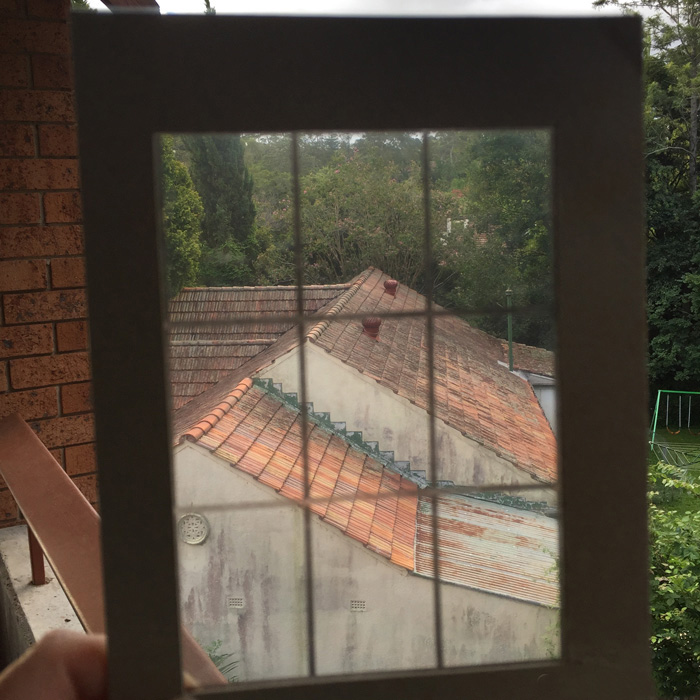
Lesson 9 of my SketchingNow Foundations course contains one of the more challenging assignments in the course – using a viewfinder.
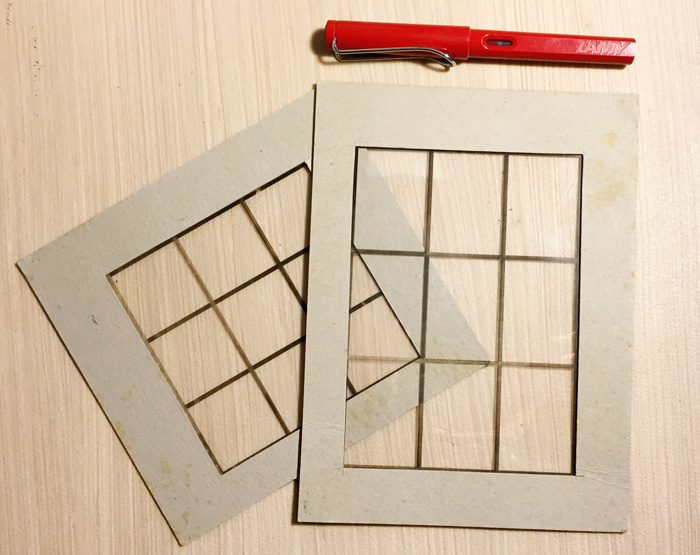
A viewfinder is a wonderful tool to help people compose, set out a view and improve accuracy, but the reality is that it’s super awkward to use on location. It’s hard to re-locate it in the right position each time, hard to remember the position of things on the grid, and perhaps the biggest issue of all, your arm gets really tired! Note. I use a big A5 size viewfinder (template is shared within the Foundations course)
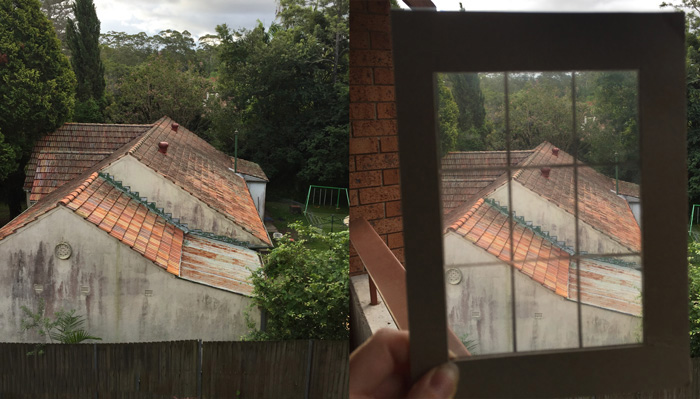
So this week I tried it again, with the intention of testing my inherent accuracy. So I revisited a subject that I had sketched loosely ‘by eye’ a few weeks ago – the house I overlook from my balcony.
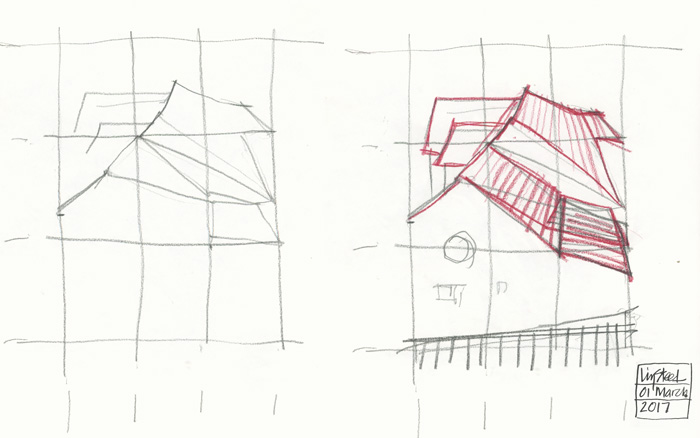
I struggled a bit doing this sketch as the viewfinder grid imposed a constraint that I am not used to. I got constantly lost with all those angles, and having two interruptions while doing the sketch didn’t help either! But it was a great exercise and I enjoyed doing it.
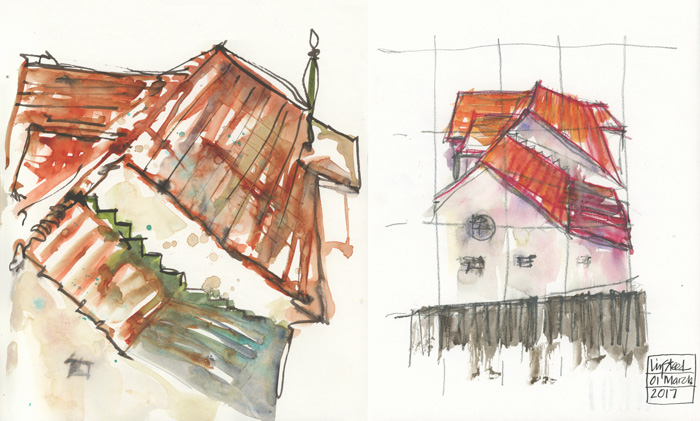
The differences with my first loose versions are huge. What did I learn from doing this exercise? Heaps!
But rather than my sharing my ideas, I thought it would be fun to throw the analysis back on you this time! So I would love to hear your thoughts on this exercise, and then in a few days time I will add a comment with my big takeaways.
This is part of a series Foundations Friday where I am revisiting the lessons of my SketchingNow Foundations online class, and exploring the concepts in a new way. To find out more about the course click here.




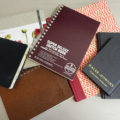
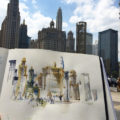
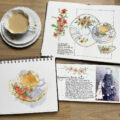
18 Comments
I really, really struggle with seeing angles. I made myself a little ‘clock face’ of clear plastic and a marker pen. It helps me if I hold it up to see what the angles are. But it is much smaller and easier to carry around. I used your template for the Foundations and found it really helpful as training, to make me see differently.
Dear Liz,
I like your “freehand” sketch better, though of course the viewfinder one is more anatomically correct.
But the freehand one has warmth and shares your sense of place, it’s just more enjoyable to my eye,
Your fan,
Nancy Greene
I’m taking the foundations course and wonder if you could share how to make a view finder. I have the template but now what do I do with it? Is there some kind of clear plastic I need and then trace the lines onto it? I am enjoying the course even though the cold here makes it difficult to work outside.
You can print the viewfinder grid that Liz provides in the Foundations course on your home printer. Then get a sheet of clear plastic that is the same size as your copier paper (from an office supply store). Put that in your paper tray and photocopy the grid on to it. I then taped the clear plastic grid on to a pre-cut framing mat.
Sorry I missed replying Laurel, and thank you Elena for answering. You can also trace over the grid by hand with a sharpie.
If you have them lying around, you can use those clear plastic sleeves that hold documents. Or clear binder dividers. Just glue on a card stock frame.
This is mind blowing! The takeaways I see are issues with foreshortening and with angles. Our brain creates illusions and we don’t see what’s really there without something to ground us into reality. Have you tried to devise a way to keep the viewfinder stable? Maybe stick it on your window or on a tripod? Do you think you’ll use it in the future outside of this experiment? Looking forward to reading your insights!
This loose version is what I seem to recall you describing as “bird’s-eye”. Striving for loose but accurate angles is quite a challenge – using eyes rather than mind. The scene reminds me of Wellington. I wish I had been sketching ten years ago, during that visit!
Thank you for your tutorial on how to use a view finder. Great examples. A view finder is another great tool for the artist’s tool box when the artist wants the drawing to be more exact. For a quick study or journaling your freehand drawing is lovely and exactly how to approach it. It demonstrates “perfect” isn’t always better (and its slower for sure). All rtists, but especially beginners, shouldn’t agonize over being perfect if it gets in the way of learning. When I use a view finder: I’m a “wanna be” plain air painter and to find myself overwhelmed with too much info so I pull out a view finder. I’m hoping that one of these days it will train my eye to not need it. I also use one when I’m working on a still life painting and know an angle is off or help with foreshortening. I think they are a tool everyone should know how to use, but also to understand when they might want to use it. So always ask yourself if it is important to your drawing or style? There are times when it will be and others not so much.
I agree a viewfinder can be “super awkward” but if the first time you sight your scene with it mark a few salient points, using a wipeable marker, it is then easy to quickly realign your grid to the scene. With your photo I would mark an inverted “V” the top roof point, the lower right roof angle and the circular motif at the lower left.
If I am using a sketch book I usually clip the grid to the top or side of my book, makes it easier, don’t have to keep putting the grid up and down. The same principle can be applied if your using a tripod, simply clip it on and no sore hands or arms.
Nice description on using the viewfinder. Too many angles confuse my newer students. This viewfinder helps clarify. Love all of your teaching ideas and photos.
I prefer your loose sketch. There are benefits to both. If you have the time and desire to do the more precise sketch (which I often do) then the grid is extremely helpful but in this instance I think that the loose sketch is more artistic and painterly. To my taste it is more attractive and has more feeling.
Hi Liz, I think the first rendition without the use of the viewfinder is a little hodge-podge and there really is nothing to draw the eye, it just ricochets off the various parts of the sketch and doesn’t know where to land. The viewfinder gives parameters for the sketch and forces you to watch where you are placing your marks so it gives a more accurate, defined rendition of the subject. Both techniques are “you” but the one through the viewfinder pulls you together! I use my camera viewfinder to capture the image I am looking for as it blocks out the rest of the detail and unwanted subject material around the same area. I think the viewfinder would do the same for a sketch. I will have to try it!
If you don’t have your view finder handy, iPhone cameras can be set to show a grid overlay on the screen, which [if it’s not too glarey] can also help with angle-checking.
Thanks for making me aware of this feature!
Regarding technology, I have heard recommendations for Jackson’s Artgrid, an app which I have now installed onto my iPad. The app overlays a grid onto a photograph and also converts to grey scale. I realise it is not ideal for rapid, loose sketches out of doors, but I am a beginner and the app is helping with my drawing practice, especially for negative spaces.
thank you everyone for the great comments – I will be addressing them in a new article soon!
NEWSLETTER
Subscribe for first notification of workshop + online classes and more.